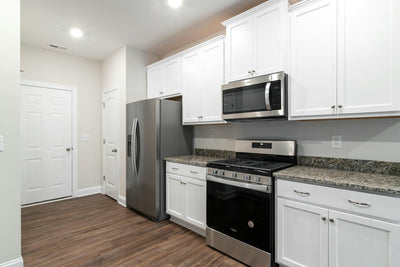Understanding Freezer Types
When deciding between a deep freezer and an upright freezer, it's crucial to understand the distinctions and how they can impact your storage, lifestyle, and space. Both have unique features suited for different needs, and recognizing these can help you make an informed decision for your home, whether it's an apartment, condo, or any living space.
Deep Freezer Overview
Deep freezers, often referred to as chest freezers, are characterized by their horizontal design and top-opening lids. They're known for providing ample storage space and retaining cold temperatures efficiently, which makes them ideal for storing large quantities of food for extended periods. The layout allows for stacking and organizing items in bulk, which can be a boon for large families or those who like to preserve food.
One of the benefits of a deep freezer is its energy efficiency. Due to the orientation and the fact that cold air doesn't escape as easily when opened, it consumes less electricity compared to its upright counterparts. Deep freezers can also operate more effectively in cooler environments such as basements or garages. For comparisons with other types of freezers and fridges that might suit your needs, you might want to explore articles such as chest freezer vs. small chest freezer or deep freezer vs. kimchi refrigerator.
Upright Freezer Overview
Upright freezers, on the other hand, feature a vertical design similar to that of a traditional refrigerator. They are equipped with shelves and door bins, which can make organization and access to items more straightforward. If you're looking for a freezer that doesn't require bending over and rummaging through layers of frozen goods, an upright model could be the right choice for you.
These freezers are typically easier to fit into living spaces due to their slim profile and can be a great addition to a kitchen or utility room. Upright freezers often come with auto-defrost features, making maintenance simpler compared to manual defrosting required by many deep freezers. For insights into how upright freezers compare to other refrigeration options, consider reading about upright freezer space considerations or freestanding beverage center vs. reach in freezer.
Both freezer types serve the purpose of preserving your food but cater to different preferences and needs. Whether you prioritize capacity, accessibility, or space optimization, considering the deep freezer and upright freezer options will guide you in selecting the best appliance for your culinary and lifestyle requirements.
Size and Capacity
When selecting a freezer, understanding the size and capacity options of both deep freezers and upright freezers is critical to meet your storage needs. Here, we compare the dimensions and storage capabilities of each type to help you make an informed decision.
Deep Freezer Size and Capacity
Deep freezers, also known as chest freezers, typically offer a larger storage capacity, which makes them ideal for storing bulk food items. The capacity is measured in cubic feet, and these freezers range from compact models around 5 cubic feet to larger units that can exceed 20 cubic feet.
| Size Category | Capacity (Cubic Feet) |
|---|---|
| Small | 5 - 9 |
| Medium | 10 - 14 |
| Large | 15 - 20+ |
The horizontal layout of a deep freezer allows you to stack items, but it may require more floor space. For more insights into optimizing storage for various freezer types, you might find our comparison of chest refrigerator vs. small freezer helpful.
Upright Freezer Size and Capacity
Upright freezers, on the other hand, feature a vertical design that is similar to that of a traditional refrigerator. They typically have a smaller footprint, which can be beneficial in tighter spaces. Upright freezers generally range from 5 cubic feet to over 20 cubic feet, similar to deep freezers but may have less usable space due to shelving and the door design.
| Size Category | Capacity (Cubic Feet) |
|---|---|
| Small | 5 - 10 |
| Medium | 11 - 18 |
| Large | 19 - 20+ |
Upright freezers are often preferred for their ease of organization and accessibility. You may find items faster due to the eye-level shelves and pull-out bins. For comparisons with other upright storage solutions, consider reading about double drawer freezer vs. freestanding wine cooler.
Both deep freezers and upright freezers come in a variety of sizes to cater to different needs, whether you're looking for a solution for your apartment, garage, or office. Assessing your space and storage requirements will guide you in choosing the best freezer type for your home. For further comparisons and to explore how freezers fit into various living spaces and lifestyles, review our articles on topics ranging from kimchi refrigerator vs. small chest freezer to apartment size refrigerator vs. shallow depth refrigerator.
Organization and Accessibility
When considering the purchase of a freezer, organization and accessibility play a pivotal role in the overall user experience. Both deep freezers and upright freezers have their own distinct interior layouts that can influence how you store and retrieve your frozen goods.
Deep Freezer Interior Layout
Deep freezers, also known as chest freezers, typically offer a large open space with a top-loading design. This allows you to store a significant amount of food, which is ideal for bulk purchases or preserving harvests. However, organization can be more challenging due to the deep layout, which may require some digging to find items at the bottom.
To alleviate this, some models come with hanging baskets or dividers that can help you categorize and separate different types of foods. Here's a simple way to visualize the layout of a standard deep freezer:
| Section | Functionality |
|---|---|
| Top Basket | Easy-to-grab items; frequently used products |
| Middle Area | Bulk items; less frequently used products |
| Bottom | Long-term storage; large or seasonal items |
For further insights on the differences in freezer layouts, consider reading about chest refrigerator vs. small freezer.
Upright Freezer Interior Layout
Upright freezers provide a front-loading design, similar to a traditional refrigerator. This vertical setup allows for a more organized approach, with multiple shelves and bins that offer clear visibility and easy access to your frozen items. The shelving system may also include door storage, providing additional space and convenience.
Here's how an upright freezer's interior may be organized:
| Section | Functionality |
|---|---|
| Top Shelves | Frequently accessed items; ready-to-eat meals |
| Middle Shelves | Daily use products; meal prep items |
| Lower Shelves/Bins | Larger items; bulk meats and vegetables |
| Door Bins | Small packages; ice packs and quick snacks |
Upright freezers can be a smart choice for those who prioritize ease of use and organization. To explore more about upright freezer features, you might be interested in the article on deep freezer vs. kimchi refrigerator.
Both freezer types have their own advantages when it comes to interior layout, and your choice will depend on your personal preferences for organization and accessibility. Consider how you plan to use the freezer, what items you intend to store, and how often you need to access them before making your decision.
Energy Efficiency
When selecting a freezer for your home or business, energy efficiency is a critical factor to consider. Not only does it impact the environment, but it also affects your electricity bill. In this section, we'll compare the energy efficiency of deep freezers and upright freezers to help you make an informed decision.
Deep Freezer Energy Efficiency
Deep freezers, also known as chest freezers, are often more energy-efficient compared to their upright counterparts. Their design allows them to retain cold air better because the opening is on the top and cold air tends to stay low. When you open a deep freezer, less cold air escapes and less energy is required to restore the temperature to the optimal level.
Another factor contributing to the energy efficiency of deep freezers is their thicker insulation, which helps maintain a consistent internal temperature, even in the event of a power outage. This energy efficiency can lead to cost savings over time.
Here's a quick overview of the energy efficiency of deep freezers:
| Deep Freezer Size | Average Energy Consumption (kWh/year) |
|---|---|
| Small (5-9 cu.ft.) | 200-250 |
| Medium (12-18 cu.ft.) | 275-350 |
| Large (Over 18 cu.ft.) | 400+ |
For more insights on how deep freezers compare to other types of freezers in terms of energy consumption, you might find our article on energy efficient refrigerator vs. mini fridge useful.
Upright Freezer Energy Efficiency
Upright freezers offer convenience and accessibility with their front-facing doors and shelves. However, this design can lead to greater energy consumption. When the door is opened, more cold air spills out due to vertical orientation, requiring the freezer to work harder to cool down again.
Despite this, many modern upright freezers are designed with energy-saving features such as automatic defrost functions and high-quality insulation. When shopping for an upright freezer, look for models with an Energy Star rating, which indicates the appliance meets energy-efficient guidelines set by the U.S. Environmental Protection Agency.
Here's a general comparison of energy consumption based on upright freezer sizes:
| Upright Freezer Size | Average Energy Consumption (kWh/year) |
|---|---|
| Small (5-9 cu.ft.) | 300-400 |
| Medium (12-18 cu.ft.) | 400-500 |
| Large (Over 18 cu.ft.) | 500+ |
For additional information on energy-efficient appliances for your specific space, consider exploring articles such as garage refrigerator vs. single door refrigerator and convertible freezer refrigerator vs. kimchi refrigerator.
In conclusion, while deep freezers generally lead the way in energy efficiency due to their design, many upright freezers are also becoming more energy-conscious. It's important to review the energy consumption specifications of the individual models you're considering to ensure you find the best for your home at Fridge.com.
Installation and Space Considerations
When choosing between a deep freezer and an upright freezer, one must consider not only the capabilities of the appliance but also the practicality of its installation and the space it will occupy. Your living environment, whether it's a home, apartment, or office, will influence your decision based on the available space and your storage needs.
Deep Freezer Installation Options
Deep freezers, also known as chest freezers, typically require a larger footprint due to their horizontal layout. When planning for a deep freezer, ensure you have ample floor space, especially since the lid opens upwards, which may not be suitable for tight spaces with low-hanging shelves or cabinets.
| Deep Freezer Size | Required Floor Space (LxW) |
|---|---|
| Small (5-9 cu. ft.) | 2'x3' |
| Medium (10-18 cu. ft.) | 2.5'x4' |
| Large (19+ cu. ft.) | 3'x5' |
To facilitate maintenance and prevent overheating, it's recommended to leave some clearance around the unit. Consider the flow of traffic in the area to avoid obstructions. Deep freezers work well in garages, basements, or utility rooms where space isn't a premium. For a comparison of space requirements with other types of freezers, see our article on chest freezer vs. small chest freezer.
Upright Freezer Space Considerations
Upright freezers offer the convenience of a smaller footprint and easier access to stored items, making them a favorable option for smaller living spaces, such as apartments or condos. They resemble a traditional refrigerator and can be easily integrated into kitchen layouts or placed in areas with vertical storage space.
| Upright Freezer Size | Required Floor Space (LxW) |
|---|---|
| Small (5-9 cu. ft.) | 2'x2' |
| Medium (10-18 cu. ft.) | 2.5'x2.5' |
| Large (19+ cu. ft.) | 3'x2.5' |
Although upright freezers take up less floor space, you'll need to ensure there's enough clearance to fully open the door, which can swing outwards or to the side. Additionally, consider the height of the unit if you're planning to install it under cabinets or shelves. For more information on how an upright freezer compares to other refrigeration solutions, refer to our article on upright freezer vs. glass door mini fridge.
In conclusion, your decision on whether to install a deep freezer or an upright freezer will be influenced by the space you can allocate and your personal storage preferences. Both options present their own set of installation requirements that should be carefully considered prior to making a purchase.
Cost and Maintenance
When deciding between a deep freezer and an upright freezer, cost and maintenance are significant factors to consider. Both types of freezers come with their own set of expenses and upkeep requirements that can influence your choice based on your budget and willingness to perform regular maintenance.
Deep Freezer Cost and Maintenance
Deep freezers, often referred to as chest freezers, typically have a lower initial purchase price compared to their upright counterparts. They are known for their efficiency and longevity, which can contribute to lower operating costs over time.
| Deep Freezer Size | Average Initial Cost |
|---|---|
| Small (5-9 cu ft) | $200 - $400 |
| Medium (10-18 cu ft) | $400 - $700 |
| Large (19+ cu ft) | $700 - $1,000 |
Maintenance for deep freezers is relatively straightforward. They require manual defrosting, which can be time-consuming but generally needs to be done only once or twice a year. It is important to keep the interior clean and to periodically check the seals to ensure they are airtight.
For those interested in exploring other freezer options that may offer more space or unique features, you may want to read about chest refrigerator vs. small freezer or deep freezer vs. kimchi refrigerator.
Upright Freezer Cost and Maintenance
Upright freezers usually come with a higher initial purchase price, but they offer the convenience of easier organization and access to your frozen goods. They also come in a variety of sizes and styles, some with additional features such as frost-free operation.
| Upright Freezer Size | Average Initial Cost |
|---|---|
| Small (5-9 cu ft) | $300 - $600 |
| Medium (10-18 cu ft) | $500 - $1,000 |
| Large (19+ cu ft) | $800 - $1,200 |
Upright freezers that are frost-free reduce the need for manual defrosting, making them easier to maintain in the long run. However, these models may consume more energy to prevent ice buildup. Regular maintenance includes cleaning the interior, ensuring the door seals are tight, and occasionally vacuuming the condenser coils to maintain efficiency.
For those who are considering different types of upright storage solutions, articles such as upright freezer space considerations or energy efficient refrigerator vs. mini fridge may offer valuable insights.
In summary, your decision between a deep freezer or an upright freezer will depend on your budget, space, and personal maintenance preferences. Both types of freezers have their own set of pros and cons, which should be weighed carefully against your needs and lifestyle.
Pros and Cons
When choosing between a deep freezer and an upright freezer, weighing the advantages and disadvantages of each is crucial for making an informed decision. Below, you'll find an examination of the pros and cons for both types of freezers, allowing you to determine which might best suit your needs and preferences.
Deep Freezer Pros and Cons
Deep freezers, also known as chest freezers, are a popular choice for long-term storage of large quantities of food. Here are some of their primary pros and cons:
Pros:
- Large Capacity: Typically offers more usable space for bulk storage.
- Energy Efficiency: Consumes less energy due to better insulation and the fact that cold air doesn't escape easily when opened.
- Longer Freeze Times: Able to keep food frozen for longer periods during power outages.
- Cost-Effective: Generally less expensive than upright models.
Cons:
- Space Requirements: Requires more floor space, making it less suitable for smaller homes.
- Organization: Retrieving items can be difficult as it involves stacking and unstacking.
- Manual Defrosting: Most models require manual defrosting, which can be time-consuming.
For those interested in further comparing deep freezers with other storage options, the article on chest freezer vs. small chest freezer provides additional insights.
Upright Freezer Pros and Cons
Upright freezers stand vertically and are designed to resemble a standard refrigerator. Let's look at the pros and cons of opting for an upright freezer:
Pros:
- Convenience: Offers better visibility and accessibility to food items with shelving and drawers.
- Space-Saving: Occupies less floor space, fitting more easily into smaller areas.
- Auto-Defrost: Many models come with an auto-defrost feature, reducing maintenance efforts.
- Versatility: Some models feature convertible compartments that can function as either a fridge or freezer.
Cons:
- Higher Cost: Tend to be more expensive than deep freezers in terms of upfront cost and energy consumption.
- Less Energy-Efficient: The vertical design means cold air escapes more easily when the door is opened.
- Limited Capacity: Offers less storage capacity than deep freezers, especially for bulky items.
To explore how upright freezers stack up against other refrigeration solutions, consider reading the comparison between upright freezer vs. reach in freezer.
By considering the pros and cons of deep freezers and upright freezers, you can choose the model that aligns with your household size, storage needs, space limitations, and budget. Each type has unique benefits and drawbacks, so consider what factors are most important for your specific situation.
Get Your Upgrade or New Addition at Fridge.com
Shop the world's best brands at Fridge.com.
Whether you're searching for your perfect fridge, freezer, wine fridge, beer fridge, ice maker, or kegerator, we have what you need.
We also have tons of awesome articles about kitchen stuff and home news. Enhance your home, garage, backyard, patio, and office with the coolest essentials. With every necessary type of residential refrigerator or freezer in our collection, we've got you covered.
Elevate your game and shop now at Fridge.com!






